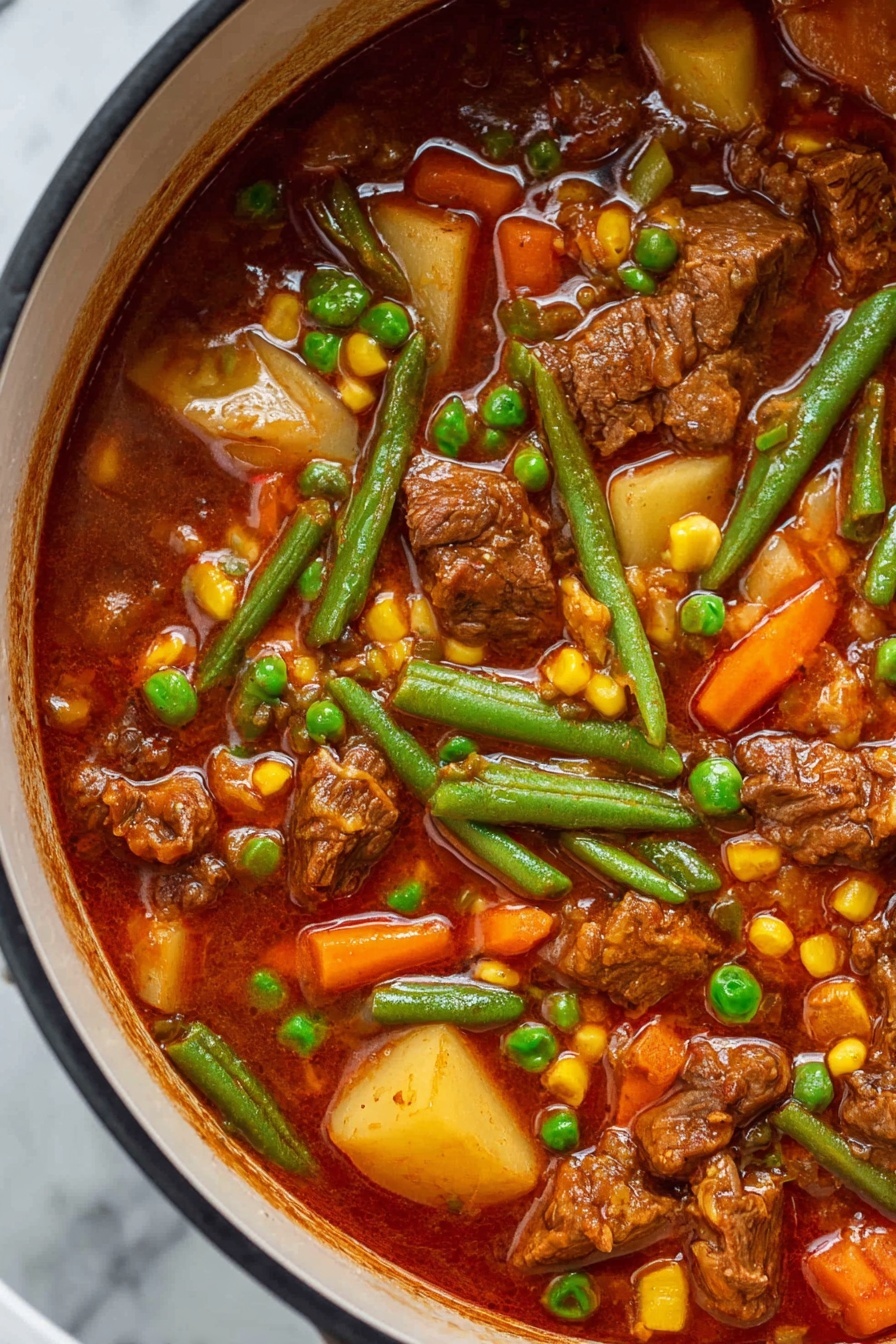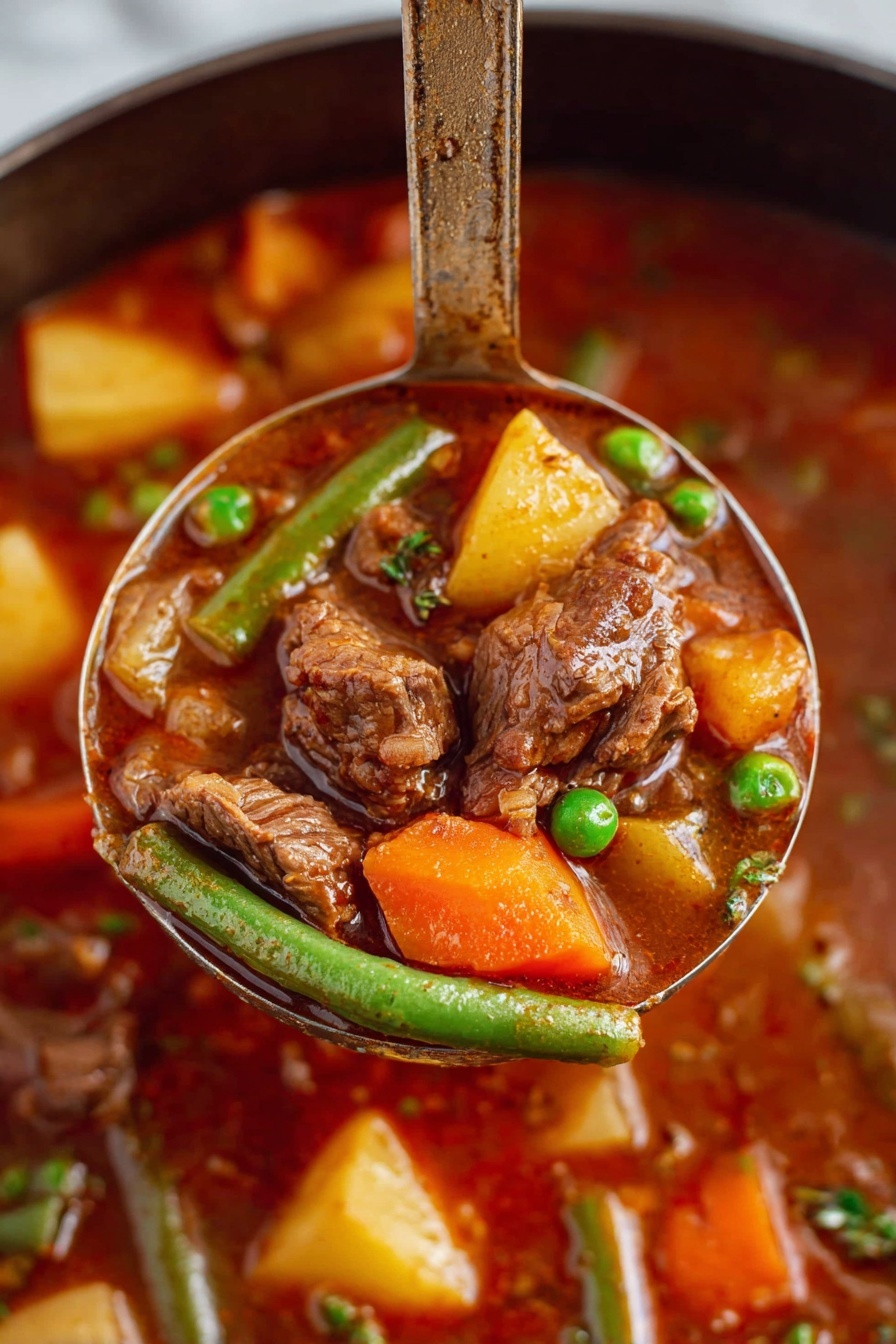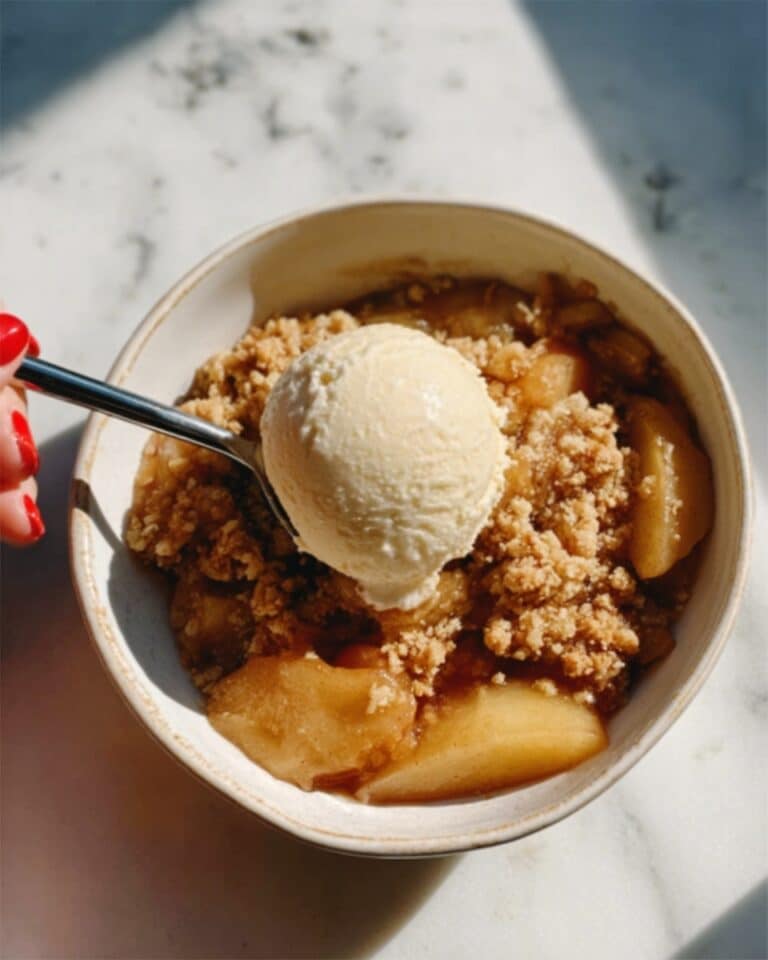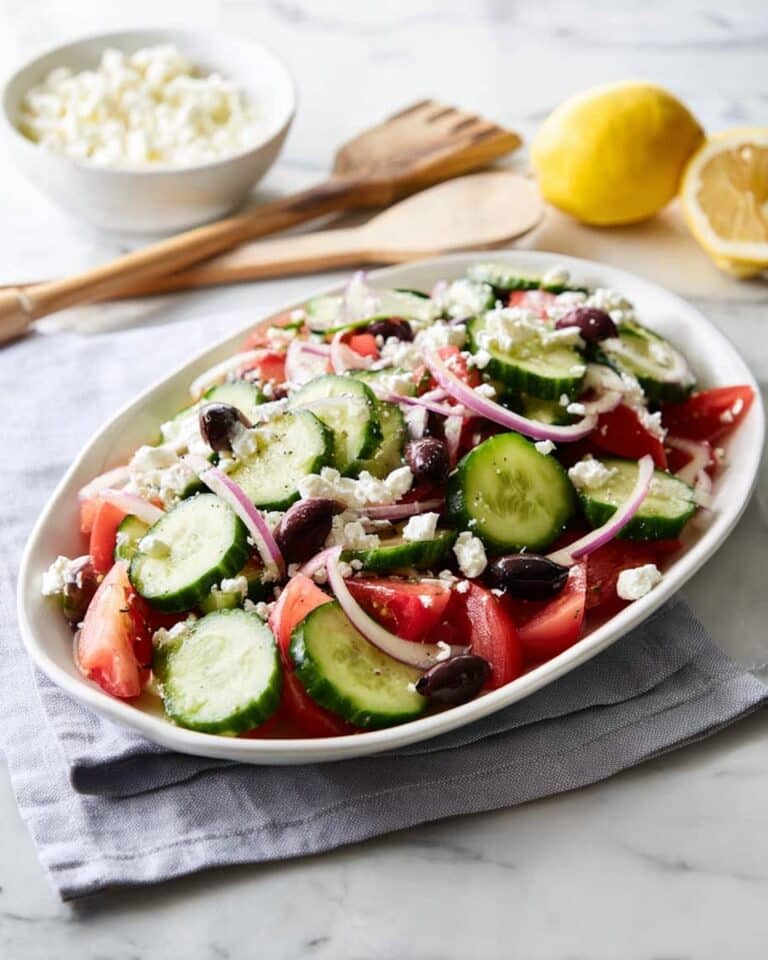If you’re craving a hearty, comforting meal that just hits the spot, you’re going to adore this Vegetable Beef Stew Recipe. I absolutely love how this stew delivers tender chunks of beef and perfectly cooked veggies swimming in a rich, flavorful broth. When I first tried this recipe, it quickly became a go-to in my kitchen because it’s both satisfying and surprisingly easy to pull together. Stick around—I’ll guide you through every step so your stew turns out just right!
Why You’ll Love This Recipe
- Rich, Deep Flavor: Slow cooking the beef and veggies together creates an unforgettable taste you’ll keep craving.
- Perfectly Tender Beef: The chuck roast breaks down beautifully, becoming melt-in-your-mouth tender without falling apart.
- A Balanced Veggie Mix: Carrots, potatoes, green beans, corn, and peas all add texture and sweetness for a well-rounded meal.
- Comfort in a Bowl: This recipe is perfect for family dinners or meal prepping since it only gets better the next day.
Ingredients You’ll Need
Each ingredient in this Vegetable Beef Stew Recipe plays a part in delivering the perfect balance of flavors and textures. Choosing fresh veggies and a good quality chuck roast makes a noticeable difference. Here are some tips on why these ingredients are the stars of the dish:

- Chuck roast: This cut is well-marbled and tough before cooking, which means it will become wonderfully tender and flavorful after slow cooking.
- Kosher salt: Enhances the natural flavor of the beef and vegetables without overpowering them.
- Black pepper: Adds a bit of warmth and subtle spice to the stew.
- Flour: Helps to brown the beef nicely and slightly thickens the broth as it cooks.
- Unsalted butter: Gives richness without adding extra salt—you control the seasoning better this way.
- Canola oil: Has a high smoke point that’s great for browning meat without burning.
- Yellow onion: Adds sweetness and depth when caramelized with the garlic.
- Garlic: Infuses a subtle earthy aroma that complements the beef perfectly.
- Carrots: Bring natural sweetness and body to the stew.
- Yukon potatoes: Hold their shape better than russet potatoes and have a creamy texture once cooked.
- Corn: Adds a pop of color and a touch of natural sugar for balance.
- Beef broth: This is the stew’s backbone—opt for a good quality broth for best results.
- Tomato paste: Concentrates umami flavors and thickens the stew slightly.
- Bay leaf: Adds a subtle herbal note that elevates the overall taste.
- Thyme: A classic herb pairing for beef that brightens the flavor without overpowering.
- Worcestershire sauce: Packs a punch of savory complexity and a slight tanginess.
- Green beans: Add freshness and a little bite to balance the tender beef.
- Frozen green peas: Sweet and soft, they’re best added near the end to avoid overcooking.
Variations
I love making this recipe my own depending on the season or what’s in my pantry. You can easily swap veggies and adjust flavors to match your family’s preferences. Experimenting keeps me excited to make vegetable beef stew all year round.
- Vegetarian version: I’ve tried swapping beef broth for vegetable broth and adding hearty mushrooms instead of meat—it’s surprisingly tasty and cozy.
- Spicy kick: Adding a pinch of smoked paprika or chili flakes was a game changer for my spice-loving friends.
- Seasonal veggies: I once tossed in parsnips and turnips instead of potatoes for a fall twist that my family adored.
- Slow cooker adaptation: If you’re short on hands-on time, this recipe works beautifully in a slow cooker—just brown the meat first!
How to Make Vegetable Beef Stew Recipe
Step 1: Season and Flour the Beef
Start by patting the chuck roast chunks dry, then sprinkle them evenly with kosher salt and black pepper. Dredge each piece lightly in flour. This coating helps develop a beautiful crust when you brown the beef, which locks in flavor and adds depth to the stew’s broth. Don’t skip this step—well-browned beef is the cornerstone of a great stew!
Step 2: Brown the Beef in Batches
Warm the butter and canola oil in a large Dutch oven over medium heat. Add the beef chunks in batches—don’t overcrowd the pan or your meat will steam instead of brown. Let each batch cook for about 3 to 4 minutes on all sides until a deep, golden crust forms. Transfer browned beef to a plate and set aside. Browning well might feel time-consuming, but trust me, it’s worth every minute for that rich flavor boost.
Step 3: Sauté Aromatics and Vegetables
In the same pot, toss in the onions, garlic, and carrots. Stir them around for 2-3 minutes until the onions start to soften and release their sweet aroma. This step builds a flavorful base that melts right into the broth. Then, add potatoes and corn, coating everything in the buttery goodness left behind from browning the beef.
Step 4: Add Liquids, Herbs, and Beef Back In
Pour in the beef broth, stirring in tomato paste until it’s well mixed. Toss in the bay leaf, thyme, and Worcestershire sauce, stirring to combine all those savory elements. Place the browned beef chunks back into the pot, nestling them in among the veggies. Cover tightly and place the pot in your preheated oven at 325°F (160°C) for about 2 and a half hours. This slow-cooking stage lets all the flavors meld together and the beef becomes tender beyond belief.
Step 5: Add Green Beans and Peas, Finish Cooking
After 2:30 hours, carefully remove the pot from the oven and stir in the green beans and frozen peas. Return it to the oven uncovered for the last 30 minutes to heat the veggies through without overcooking. Once done, pull out the bay leaf before serving – it’s there for flavor but not for eating. Voilà! Your stew is ready to enjoy.
Pro Tips for Making Vegetable Beef Stew Recipe
- Brown in Batches: Avoid crowding the pot when browning beef to ensure a deep, flavorful crust instead of steaming.
- Use a Dutch Oven: Thick-walled pots like Dutch ovens distribute heat evenly and keep moisture locked in for tender results.
- Low and Slow Cooking: Giving the stew ample time in the oven breaks down collagen in beef, making it melt-in-your-mouth soft.
- Don’t Skip the Bay Leaf: It adds subtle depth but always remember to remove it before serving!
How to Serve Vegetable Beef Stew Recipe
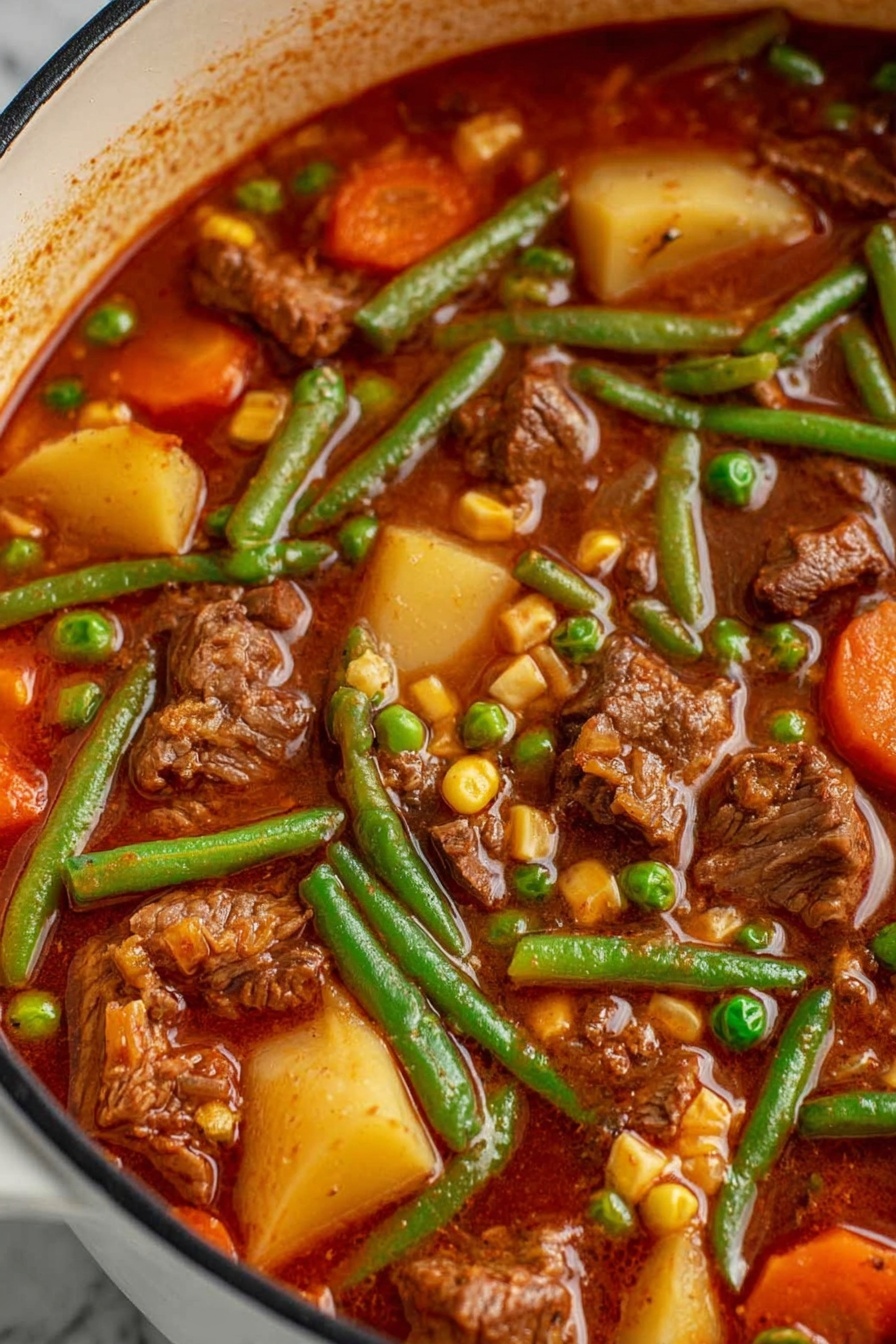
Garnishes
I like sprinkling a handful of chopped fresh parsley or thyme right on top of the stew just before serving—it brightens the dish beautifully. Sometimes a dollop of sour cream or a little grated Parmesan on top adds a lovely creamy contrast that my family enjoys.
Side Dishes
Crusty bread or buttery dinner rolls are my go-to choices for soaking up every last bit of the delicious broth. Sometimes, a simple side salad with a tangy vinaigrette balances the richness of the stew. Mashed potatoes or polenta can also be fantastic bases if you want to turn the meal into a hearty feast.
Creative Ways to Present
For special occasions, I’ve served this stew in individual mini Dutch ovens or rustic bread bowls—guests always love the cozy presentation. A sprinkle of microgreens or edible flowers on top adds a festive touch. Even simple wooden bowls and linen napkins make the experience feel extra homey and inviting.
Make Ahead and Storage
Storing Leftovers
After your stew cools, I recommend transferring it to an airtight container and storing it in the fridge. It keeps beautifully for up to 4 days, and honestly, I think it tastes even better the next day once the flavors have had time to meld. Just give it a good stir before reheating.
Freezing
I’ve frozen this vegetable beef stew multiple times with great success. Let it cool completely, then portion it out into freezer-safe containers. It can be frozen for up to 3 months. When you’re ready, thaw it overnight in the fridge before reheating gently on the stove to preserve the texture of the veggies and beef.
Reheating
The best way I found to reheat leftover stew is over low to medium heat on the stove, stirring occasionally. This keeps the beef tender and the vegetables from getting mushy. If the broth has thickened too much in the fridge, just add a splash of beef broth or water to loosen it up.
FAQs
-
Can I use a different cut of beef for this stew?
Absolutely! Chuck roast is ideal because of its fat content and connective tissue that breaks down beautifully during slow cooking. However, brisket or short ribs also work well. Just keep in mind they may have slightly different cooking times.
-
Is it okay to skip flour when browning the beef?
You can skip flour if you want a gluten-free stew, but the flour helps with browning and thickening the stew. If avoiding flour, consider using cornstarch or arrowroot powder instead, or thicken the stew at the end with a slurry.
-
Can I make this stew in a slow cooker?
Yes! Brown the beef on the stove first to boost flavor, then transfer everything to a slow cooker. Cook on low for 7-8 hours or high for 3-4 hours, adding delicate veggies like peas in the last 30 minutes.
-
How can I thicken the stew if it’s too thin?
You can simmer it uncovered for a bit longer to reduce the liquid, or mix a tablespoon of flour or cornstarch with cold water and stir it in, cooking until thickened. Adding mashed potatoes also helps naturally thicken the broth.
-
What’s the best way to store leftover stew?
Transfer cooled stew to airtight containers and refrigerate for up to 4 days. For longer storage, freeze in portions for up to 3 months, thawing overnight before reheating.
Final Thoughts
This Vegetable Beef Stew Recipe holds a special place in my heart because it’s the kind of dish that warms more than just your stomach—it comforts your soul. Whether you’re feeding a family or prepping for cozy solo meals, this stew delivers consistently tender beef and perfectly cooked vegetables every time. Give it a try; I promise you’ll be making it again and again. Trust me, your kitchen is about to become your favorite place to be on a chilly night.
Print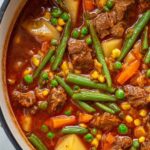
Vegetable Beef Stew Recipe
- Prep Time: 15 minutes
- Cook Time: 3 hours 10 minutes
- Total Time: 3 hours 25 minutes
- Yield: 8 servings
- Category: Stew
- Method: Baking
- Cuisine: American
Description
A hearty and comforting Vegetable Beef Stew made with tender chuck roast, a medley of vegetables, and rich beef broth, slow-cooked in the oven to develop deep flavors. Perfect for a cozy meal.
Ingredients
Beef and Seasoning
- 3 pounds chuck roast, cut into 2″ chunks
- 1 teaspoon Kosher salt
- 1/2 teaspoon coarse ground black pepper
- 2 tablespoons flour
Cooking Fats
- 2 tablespoons unsalted butter
- 2 tablespoons canola oil
Vegetables
- 1/2 yellow onion, chopped
- 4 cloves garlic, minced
- 2 carrots, cut into 2 inch chunks
- 2 Yukon potatoes, chopped
- 1 cup corn
- 1 cup green beans, fresh or frozen
- 1 cup frozen green peas
Liquids and Seasoning
- 4 cups beef broth
- 1/4 cup tomato paste
- 1 bay leaf
- 1 teaspoon thyme
- 1 tablespoon Worcestershire sauce
Instructions
- Preheat and Season: Preheat the oven to 325 degrees Fahrenheit. Season the beef chunks evenly with kosher salt and black pepper, then dredge them in flour to coat.
- Brown the Beef: Heat the butter and canola oil in a large dutch oven over medium heat. In batches, brown the beef on all sides for about 3-4 minutes per batch until well browned. Remove beef and set aside.
- Sauté Vegetables: In the same pot, add chopped onions, minced garlic, and carrots. Cook for 2-3 minutes until slightly caramelized, stirring occasionally to prevent burning.
- Add Remaining Vegetables and Liquids: Add the chopped potatoes and corn to the pot. Pour in beef broth, then add tomato paste, bay leaf, thyme, and Worcestershire sauce. Stir well to combine all ingredients.
- Combine and Cook: Return the browned beef to the pot, cover with a lid, and place in the preheated oven. Cook for 2 hours and 30 minutes to allow flavors to meld and beef to become tender.
- Add Final Vegetables: After 2 hours and 30 minutes, add green beans and frozen peas to the stew. Return the pot to the oven and cook uncovered for an additional 30 minutes.
- Finish and Serve: Remove the bay leaf from the stew before serving. Ladle the stew into bowls and enjoy warm.
Notes
- Using a dutch oven is ideal for even heat distribution during browning and oven cooking.
- Allow the stew to rest for a few minutes after cooking before serving to let flavors settle.
- Frozen vegetables can be swapped for fresh ones if preferred; adjust cooking times accordingly.
- This stew can be made a day ahead and often tastes better the next day.
- For a thicker stew, reduce the broth slightly or mash some potatoes into the liquid.
Nutrition
- Serving Size: 1 cup
- Calories: 350
- Sugar: 6g
- Sodium: 550mg
- Fat: 15g
- Saturated Fat: 6g
- Unsaturated Fat: 7g
- Trans Fat: 0g
- Carbohydrates: 25g
- Fiber: 4g
- Protein: 30g
- Cholesterol: 85mg

